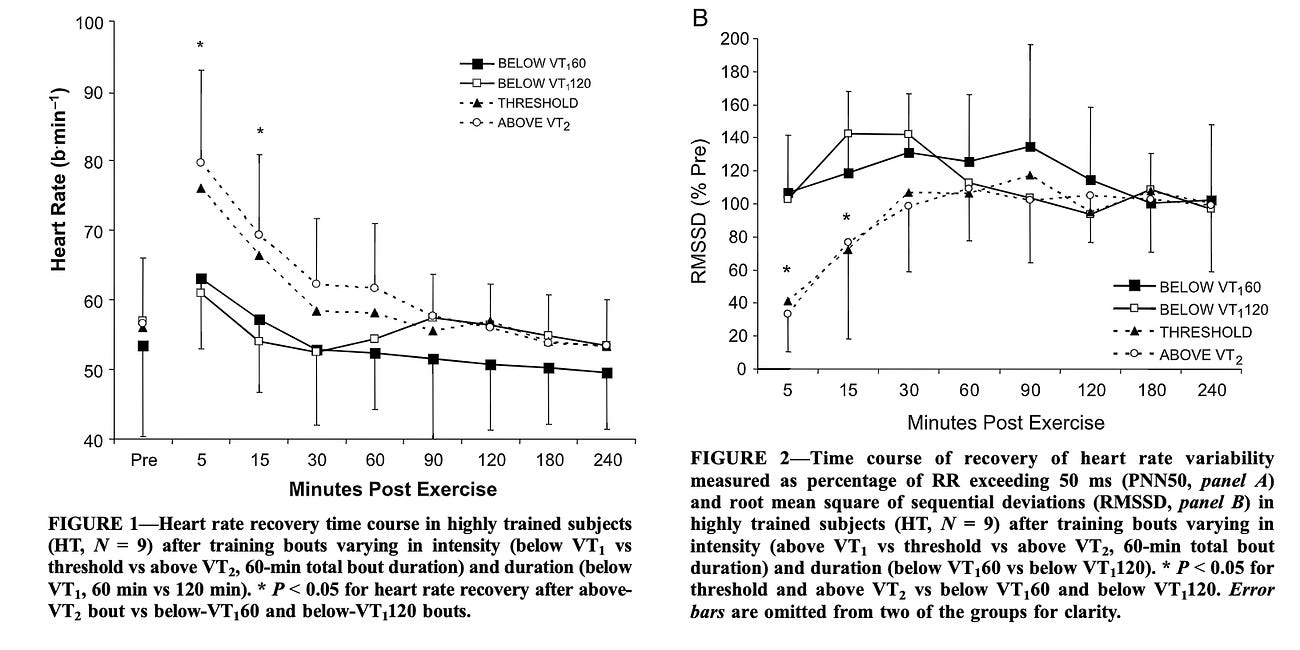Q&A: Should we measure HRV in the morning or before exercise?
some important considerations on measurement timing based on our application of interest
hi there,
Below is a question that came in recently through HRV4Training’s customer support channel, which I think can be useful to others, hence I’ve started a new series of short Q&A blogs (considering that I’ve decided not to spend my time on Twitter / X anymore, I will try to use Substack for more than the usual longer posts or newsletters). Please always feel free to comment below if you have any doubts or additional questions.
Here is the question, concerning measuring time:
Quick question please that I have been wondering about for a while. I know you prefer taking measurements upon waking up. But I have had situations where I have woken up with a lower score. But as the day proceeds during an easy day, my HRV improves to a point where it is up say from 36ms and its 45ms by 4pm, when I'm ready for a workout.
So, is it not more useful to take measurements just before a workout to get a more reliable state of readiness?
I think there are some good points in this question, to unpack a bit. First and foremost, we need to state the context and goal here, as HRV can have many different uses, and the best protocol always depends on our use case.
Here we are interested in capturing overall physiological stress as a marker of ‘readiness’, therefore to guide training (e.g. to reduce training in case our body is already stressed, so that we can put ourselves in a better place to absorb and respond positively to training stress).
In this context, then morning measurements are best (see here and here).
Even in this context, it makes sense that if we do not train in the morning, as time passes, our state might change. We often think in terms of days when we should probably think in terms of hours (e.g. if I am not great from a muscular point of view, maybe I won’t train tomorrow morning but I will be better tomorrow night, as another 10-12 hours have passed - similar considerations could be done for other forms of recovery, e.g. from an autonomic nervous system point of view).
However, we need to remember the limitations of the data we are using: HRV is unable to provide us with a snapshot of how our recovery is progressing during the day, due to too many confounding factors (the circadian rhythm, physical activity, and even just drinking water - which can elevate your HRV for hours - and has nothing to do with your recovery). This is why I don't believe we can build “real-time stress monitor”, the way wearables companies, unfortunately, claim. The link between parasympathetic activity (a marker of the stress response) and HRV breaks when we measure outside of very controlled conditions (let alone all the other issues associated with the technologies used - which are not able to acquire high-quality data - and the oversimplifications that translate any normal acute physiological response something pathological). Make sure to read this article too, if you are interested in understanding the limitations of HRV data outside of very controlled settings, at rest, and far from stressors and confounding factors (i.e. first thing in the morning, or in the night).
Hence in this case, my recommendation is to continue to measure in the morning, but then if you train in the afternoon and feel better by that time, you might simply be less strict on the morning daily advice and adjust accordingly. HRV is not there to override your subjective feel, but as an extra tool that can help you better understand certain responses and make small but meaningful adjustments from time to time.
Is there a use for measuring before a workout? Yes, this is also a potentially useful application, even though with limited practical applicability. The idea here is to measure before and after the workout to assess the intensity of the workout, not to determine your readiness based on the measurement taken before your workout.
For example, research has shown that your HRV should re-normalize within a few minutes when you exercise below the first lactate or ventilatory threshold, which is not the case for harder workouts. Hence pre-post measurements can serve as a sort of diagnostic tool for your sessions.
The limited practical applicability outside of the lab here is due to the same issues I’ve highlighted for ‘stress monitors’, i.e. after your workout, if you want to track your HRV and compare it with your pre-workout measurement, you need to sit, not move, not talk, not drink not eat, not shower, etc. - you see why these things are not really usable. Any other thing you do, will make the data completely useless to assess your physiological response, just like ‘real-time stress monitors’.
Here is a blog where I covered this application in more detail:
Marco holds a PhD cum laude in applied machine learning, a M.Sc. cum laude in computer science engineering, and a M.Sc. cum laude in human movement sciences and high-performance coaching.
He has published more than 50 papers and patents at the intersection between physiology, health, technology, and human performance.
He is co-founder of HRV4Training, advisor at Oura, guest lecturer at VU Amsterdam, and editor for IEEE Pervasive Computing Magazine. He loves running.
Social:
Twitter: @altini_marco.
Personal Substack.





